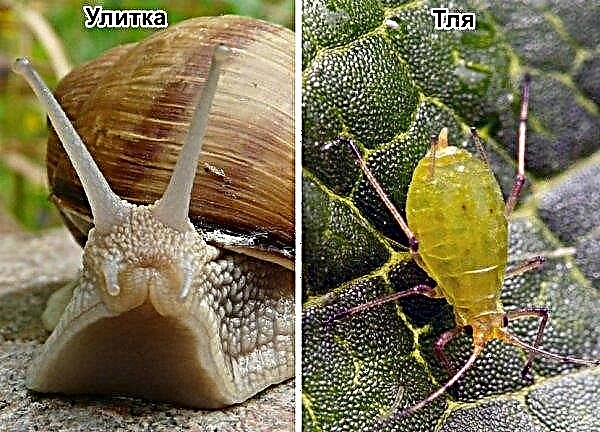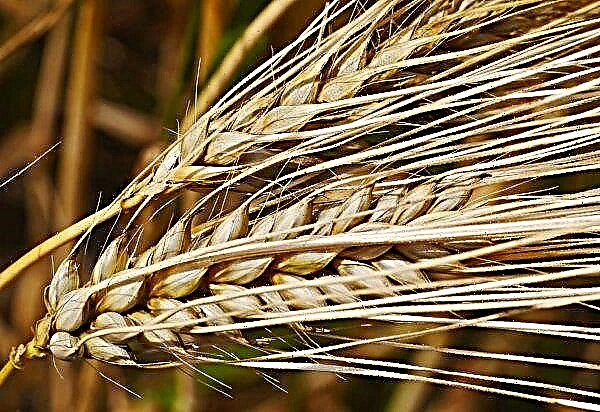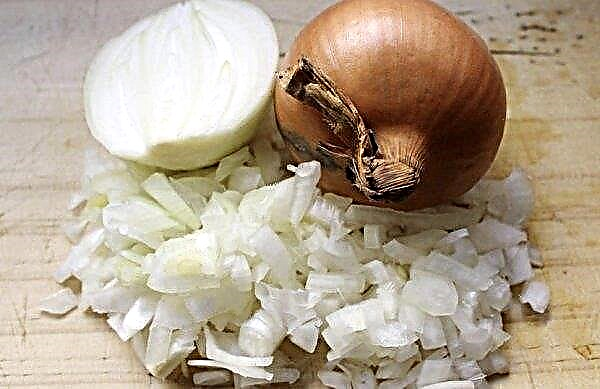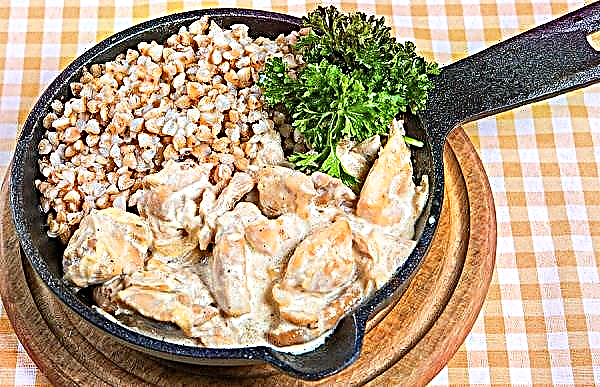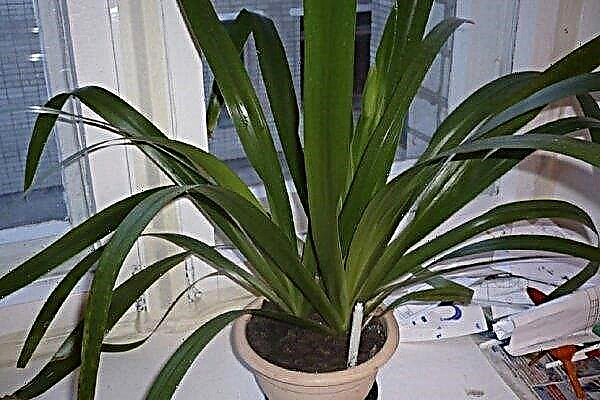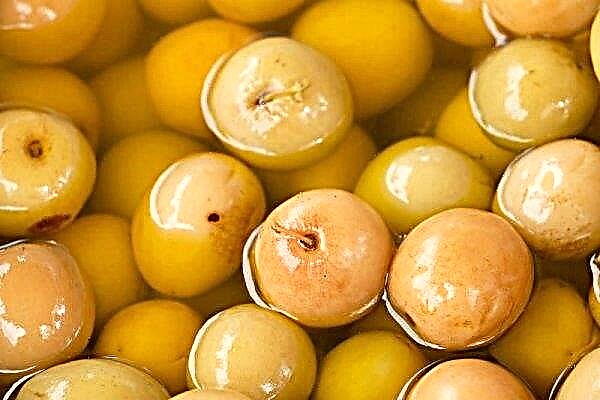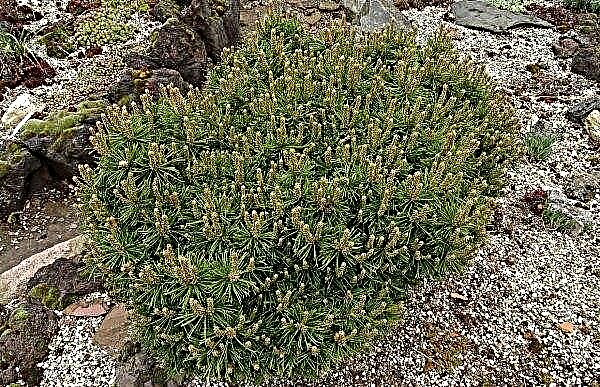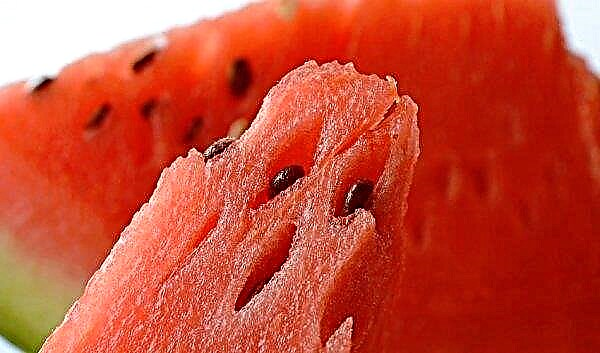The spider mite is a fairly small pest, but it causes visible damage to plants. In this article, we will understand what kind of parasites they are, where they come from and by what signs they can be recognized. We will also tell you how to prevent the appearance of spider mites on cucumbers, what measures can be taken at home to protect plants, and with what drugs they need to be treated.
What is a spider mite and what does it look like?
A spider mite is a pest belonging to the class of arachnids. The place of his settlement was initially the back side of the leaves of plants, after a while he is chosen on the outside of the leaf. Also, this animal can settle in the upper layer of soil or fallen foliage.
This parasite is small in size: its body is in length from 0.2 to 1 mm. Tick color can be yellow, red or orange.Important! The spider mite is resistant to drugs designed to kill arachnid pests.
 The tick feeds on the cellular sap of various trees, herbaceous and coniferous plants. He has a special love for cotton, melons, garden, indoor plants, as well as ornamental crops located both in open ground and in the greenhouse. On plants of these species, the spider mite multiplies more actively.
The tick feeds on the cellular sap of various trees, herbaceous and coniferous plants. He has a special love for cotton, melons, garden, indoor plants, as well as ornamental crops located both in open ground and in the greenhouse. On plants of these species, the spider mite multiplies more actively.The salivary glands of this pest contain an enzyme that, when excreted, destroys the chloroplasts of culture cells. Thus, the tick disrupts the process of photosynthesis. In addition, he sucks out juices from the culture, due to which the plant subsequently becomes more vulnerable due to the weakening of immunity and is more often exposed to infectious diseases, often cucumbers even dry and eventually die.
Did you know? Even the wind can provoke the appearance of spider mites on cucumbers.
Signs of a spider mite on cucumbers
You can find out that a small parasite has appeared in your garden and is actively attacking cucumbers by the following signs:
- light, sometimes white dots appear on the back of the leaves. Their appearance is due to the fact that the tick pierces the surface of the leaf in order to suck out the vegetable juice. At the puncture site, light traces remain, expressed in white coating;
- the surface of the leaves becomes unhealthy, the leaves turn yellow;
- vegetable growth slows markedly;
- the cucumber bushes were covered with a thin, almost transparent web, along which the pests moved;
- the cucumbers are withered. This happens after a long stay of the tick on the bush.

Important! The presence of white spots on the plant suggests that the spider mite has settled on the culture for a long time and managed to cause significant harm to it.
Where does the spider mite come from
Cucumber bushes are a crop that is most often attacked by spider mites. This is because it is this plant that is often grown in greenhouses, where a temperature comfortable for pests is maintained.
When choosing a place of residence, the spider mite draws attention to two conditions - a dry climate and air temperature, whose average annual rate should be from 4.5 ° C and above. The higher the ambient temperature, the more actively the pest multiplies and its larvae mature faster.
A small parasite lives in the upper layers of the soil, manure, and hibernates in the fallen leaves or corners of greenhouses. The reason for its appearance may be the seedlings on which the tick settled, or domestic animals, on the skin of which it is also transferred.
What to do and how to deal with a pest
If you can’t protect your garden from the attack of spider mites, then you need to figure out how to deal with a small pest and what methods of control should be adopted to reduce the risk of it appearing in the beds.
In the greenhouse
Cucumber bushes growing in the greenhouse are in particular danger. This is because a small parasite loves a place with a warm climate and fairly dry air, so the greenhouse is an ideal place for tick propagation.
To get rid of the pest and save your crop, it is recommended to follow the following recommendations:Important! Any measures to destroy the pest must be taken only after the harvest.
- It is necessary to disinfect the greenhouse (also called fumigation). The procedure is carried out twice a year - in the autumn after harvest and in the spring on the eve of sowing.
- It is important to remove the topsoil, in which ticks often hide, immediately after harvesting.
- Burn trellis with a gas burner.
- As a fertilizer, it is better to use phosphorus mixtures.
- An increase in humidity helps prevent spider mite from multiplying. This pest prefers a dry climate, that is, humidity not exceeding 60%. Raising the humidity level to 85% will not harm the cucumber bushes, but will become unacceptable for parasite life.

In the open ground
To destroy a small parasite and prevent it from attacking cucumber bushes growing in the open ground, the following steps must be taken:
- on the eve of sowing, it is imperative to dig up the soil, since the top layer of the earth serves as a tick for wintering;
- clean the beds from the appearance of weeds. If the soil is not well dug up enough and part of the parasites overwintered in the ground, then initially ticks multiply on weeds and only after that migrate to cucumber bushes;
- to inspect the plants and, if symptoms of a tick attack are detected, get rid of the affected areas;
- Do not plant cucumbers every year in the same place. It is advisable to alternate the planting of cucumber crops with tomatoes or cabbage;
- treat the lesion with the help of biological preparations.
What remedies and drugs can be used for treatment
In order to protect cucumbers from the attack of a spider mite, you first need to properly care for the plant. However, this is not the only method that is used to protect the culture from a small pest. To reduce the risk of pests, cucumber bushes should be treated. Various drugs will come to the rescue in this situation. Among them, we will highlight folk remedies, chemical and biological products.
To reduce the risk of pests, cucumber bushes should be treated. Various drugs will come to the rescue in this situation. Among them, we will highlight folk remedies, chemical and biological products.
Before giving preference to any of the funds, we recommend that you familiarize yourself with them in more detail. So you can find the method that is most suitable for you and find the best solution for your problem.Important! Preparations with a high content of chemically active substances are the most effective means in pest control, but it is also the most unsafe for both cucumbers and humans. Accordingly, chemistry it is necessary to apply only in case of mass infection of plants with a tick.
Chemical
The use of these drugs is advisable only if alternative methods do not help and the parasite actively propagates on cucumber bushes. In such a situation, it is recommended to pay attention to insecticides. Among them, “Actellik”, “Kartofobs”, “Dakofol”, “Karbofos”, “Neoron”, “Tiovit Jack” or colloidal sulfur are distinguished. When using any chemicals, it is important to strictly follow the instructions so as not to harm the plant. In addition, you need to change the drug once or twice a month so that the ticks do not develop resistance to the components.
When using any chemicals, it is important to strictly follow the instructions so as not to harm the plant. In addition, you need to change the drug once or twice a month so that the ticks do not develop resistance to the components.
Important! To defeat the Putin tick, it is necessary to process plants in the early morning or evening. At this time, air temperature is lower and sunlight is less. Due to this, the active components that destroy pests do not evaporate and act as efficiently as possible.
 You can also learn from the instructions about how often it is necessary to treat cucumber bushes with the drug, what dose to use and other nuances of spraying the plant. But there is a rule that applies to all chemicals: for the last time, the pest must be poisoned no later than 21 days before the fruiting begins.
You can also learn from the instructions about how often it is necessary to treat cucumber bushes with the drug, what dose to use and other nuances of spraying the plant. But there is a rule that applies to all chemicals: for the last time, the pest must be poisoned no later than 21 days before the fruiting begins.Another drug that is often used to treat plants is called Fitoferm. It is less toxic than other chemicals and is an insecticide of biological origin. "Fitoverm" is safe for the health of both plants and humans, and after spraying with the product, the crop can be eaten after 2-3 days.
Folk remedies
Such methods of processing plants are considered more gentle and suitable for use at an early stage of infection of cucumbers. The following tools will help fight a pest:
- Ammonia. For spraying the bushes, a mixture is prepared consisting of 10 liters of pure water and 1 tablespoon of ammonia. Processing plants should be carried out 3-4 times. The interval between procedures should be 7 days if you spray the bushes at a temperature of + 20 ° C, and 3-4 days if you process the bushes at an air temperature of + 30 ° C.
- Garlic. On its basis, a concentrate is initially prepared, for which 150 grams of garlic and 1 liter of water will be required. Garlic should be infused in water for a week, after which the resulting liquid should be diluted with water - 6 ml of the concentrate is diluted in 1 liter of pure water.
- Tobacco dust. To prepare a solution of 200 grams of tobacco, pour 1 liter of water, insist for 14 days, then strain and dilute with water in a ratio of 1:10 - for adult bushes, or 1:20 if the cucumbers are young. The resulting solution needs to be sprayed with plants.
- Tar soap. A mixture for spraying is also prepared on its basis. For 10 liters of water it is required to dissolve a bar of soap weighing 100 grams and process the cucumbers with the resulting solution 2 or 3 times a week.
- Ash. To prepare the solution, you need to take 300 grams of ash, pour boiling water and boil for 60 minutes. Then the solution must be filtered and diluted in 10 liters of water. Such a solution should be treated bushes twice a month.
- Iodine. With its help, it is possible to carry out the prevention and treatment of cucumber bushes. To prepare the mixture with iodine, you need to take 10 parts of water, 1 part of milk and 7-10 drops of iodine. The resulting solution must be processed whip bushes on both sides.
- Vodka. To prepare the solution, you need to take 2 tablespoons of vodka and 0.5 liters of water, the resulting mixture to process the leaves of cucumbers. Dense leaves can be wiped with a cotton pad.
- Soda. For the solution, 50 grams of soda, 50 grams of soap and 10 liters of water are taken. The ingredients are mixed, the resulting product is treated with bushes.
- Onion peel. Initially, half a bucket of onion husks is poured with 10 liters of clean water, the temperature of which does not exceed 60–70 ° C, and insist for 24 hours. The resulting solution must be diluted with water in this ratio - 1 part of onion infusion to 2 parts of pure water.
- Vinegar. To prepare the solution, you need to take 2 teaspoons of vinegar in 8 liters of water, mix thoroughly and process the seedlings of cucumbers with the help of the obtained product.
Did you know? Bilateral treatment of cucumber leaves with ammonia solution not only contributes to the destruction of pests, but also saturates the plant with nitrogen.
What diseases can a spider mite cause?
The negative consequences of the appearance of the pest described above can be supplemented: often an attack of a plant with a spider mite leads to a disease such as gray rot. This ailment spreads on the outside of the cucumber bushes, affects its leaves, peduncles, shoots and appears even on fruiting bushes.
How to protect cucumbers from spider mites: prevention
As we already said, it is impossible to fully protect cucumbers from the invasion of the spider mite. However, its occurrence can be prevented if timely preventive measures are taken.
To reduce the risk of developing a spider mite, the following rules for caring for the plant must be observed:Important! Particular attention should be paid to plants during their active development and growth.
- Timely weeding of beds. Weeds can also become an object of attack by ticks, so it is important to keep the space clean and get rid of excess vegetation.
- Settlement nearby with cucumbers of plants that repel a pest, such as dill. You also need to plant protective plants in the corner parts of the greenhouse.
- Getting rid of bushes from infected parts of the plant at an early stage. Affected materials must be burned to destroy the pest.
- Planting cucumbers in the greenhouse must be alternated annually with the planting of tomatoes or other permitted plants.
- Disposal of plant residues after harvest. To avoid possible pest infection, residual materials must be destroyed.
- Periodic inspection of cucumber bushes for symptoms of the appearance of a spider mite. The sooner a pest is discovered, the faster it can be dealt with.
- Maintaining optimal humidity levels in the greenhouse.
- The annual digging of the soil after harvesting helps to reduce the risk of ticks that can hide in the upper layers of the soil.
- Observing the distance between the cucumber bushes or alternating cucumbers with other crops. Thanks to this, it will be more difficult for ticks to envelop the bushes with cobwebs, therefore, their movement from one plant to another will become slower.

Spider mite resistant cucumber varieties
There are varieties of cucumbers that are less likely to attack ticks. Among them are the following:
- Ryabinushka;
- Dunyasha;
- Ideal;
- Zhukovsky;
- Knight;
- Caprice;
- Sir;
- Bunny;
- Tanya.
Did you know? The spider mite does not represent danger to hhuman body.
Regardless of which variety of cucumbers you plant on your site, you need to remember that none of them are 100% protected from spider mites. It is important to remember that the best way to save cucumber bushes from the appearance of a spider mite is timely prevention. Carefully take care of your plants, monitor their health and only in this way you will reduce the risk of small pests to a minimum.

